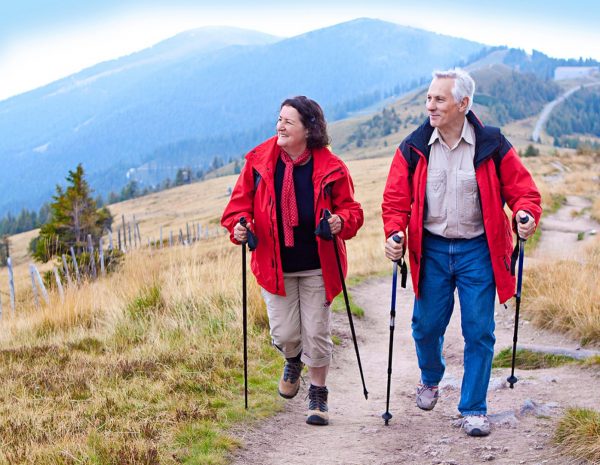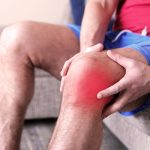Back in the 1980’s, the airwaves were filled with a song that wanted everyone to walk like an Egyptian. I never really understood the song itself, but I have to admit. All of the moves and grooves that went with it were great forms of physical activity.
Anyone who wanted to participate had to raise their hands, dip their knees and shake their hips. So it was a fun and exciting way to get people moving!
Now I have a new move for you. It’s called Nordic walking.
Walk Like a Norwegian!
Walking at a normal gait and with regular body movement is good for you. I will never say it isn’t.
But, alone, it’s not enough to improve whole-body strength, coordination and fitness.
The problem comes from the lack of upper body movement. There is none. So walking only has a moderate effect on your aerobic capacity and lung strength. And it does very little to improve bone mass (however, keep in mind that it does limit continued loss).
This is why I always recommend a well-rounded exercise program that includes high intensity workouts that combine aerobic, strength and resistance training activities. But not everyone takes that advice.
On the other hand, there is one particular way of walking that can come pretty close to giving you a whole-body workout.
Unlike normal walking (or running for that matter) which only activates about 40% to 60% of your body’s muscles, Nordic walking trains about 90%.
You see, when you go out for a regular walk, the only muscles that get a workout are those in your lower body. Your upper body is effectively a passenger. It just comes along for the free ride.
But just imagine what would happen if you could engage your triceps, abs, chest, neck and shoulders while walking – without reducing any lower body benefits!
Think about how many more calories you could burn and how much lean muscle you could develop if the simple art of walking provided you with a total body experience. I’m talking about arms, shoulders and back muscles that are perfectly toned. Stronger core muscles, better stability and even improved posture.
It’s just as important to consider the other health benefits that a full-body walk can provide. What it will do for your heart and lungs… how it can help ease pain and stiffness… cut down on inflammation… the effect it can have on your strength, stamina and balance.
And here’s the best thing of all. It’s not hard to do!
It’s actually easier and safer than walking normally! This makes it a great form of exercise for people who don’t make time for a well-rounded exercise program and those with physical ailments. (Although, as always, I do recommend checking with your physician prior to starting a new exercise activity.)
What is Nordic Walking?
Nordic walking is a popular sport in Scandinavia and other European countries. It’s often called “ski walking,” since it requires the use of walking sticks that resemble ski poles. The sport is so widely practiced that avid walkers participate in Nordic walking festivals, marathons, competitions and other events.
Despite this international popularity, Nordic walking has been very slow in coming to the U.S. But I suspect it won’t be long until it becomes a hot topic here in the states. First it will be a few celebrities who will participate, then everyone else will want to get involved. And you can be at the forefront of this “new” and fun form of exercise.
In contrast to many of the exercises I recommend, it does require an initial cash outlay. You’ll need to purchase a pair of Nordic walking poles.
Unlike regular walking or trekking sticks, these poles have a special wrist strap, or glove. It’s absolutely necessary for proper Nordic walking because as you push your body forward you need to let go of the pole.
Select a pair of poles that have a height adjustment so you can adjust them to a length that is right for you. They should be adjusted so the tip is on the ground when your arms are bent at a 90 degree angle by your sides.
There are certain attachments that should come with your poles. In particular, a rubber tip is used for paved surfaces. It can be removed to reveal a pointed tip for use when walking in grass, sand and dirt.
Once you have yourself strapped in, give yourself time to adapt to the poles. First, grasp both poles in your hand and carry them beside you while walking normally. Your left arm and right foot should move in tandem, just like they always do.
Next, let go of the poles. Just drag them beside you as you walk. You’ll notice how the poles angle down and backward at a 45 degree angle.
When you are comfortable with these two steps, you can start “planting” and “pushing.” As you step forward with your right foot, grip the pole in your left hand and firmly plant it halfway between the heel of your right foot and the toes of your left. Keep your elbow close to your body and push off.
As your left arm swings backward, release the grip on the pole. At the same time, grip and plant the pole in your right hand.
Repeat the process with each step.
Initially, it’s a good idea to get some one-on-one training to learn how to use the poles. But if you can’t find a trainer in your area, there are plenty of online videos that can show you how to use your walking sticks.
The best source I’ve found for such videos is this one. Once you visit this site, you’ll see a complete menu of “chapters” on the left side of the screen. They will take you all the way from learning how to use your poles, to fun exercises that can expand your Nordic walking experience for even greater health benefits.
Remember, life is movement. Start with a shorter time using your walking sticks and build up to your tolerance level… and then just keep on moving!
SOURCES:
Kukkonen-Harjula K, et al. Effects of walking training on health-related fitness in healthy middle-aged adults–a randomized controlled study. Scand J Med Sci Sports. 1998 Aug;8(4):236-42.
Church TS, et al. Field testing of physiological responses associated with Nordic Walking. Res Q Exerc Sport. 2002 Sep;73(3):296-300.
Takeshima N, et al. Effects of Nordic Walking Compared to Conventional Walking and Band-Based Resistance Exercise on Fitness in Older Adults. J Sports Sci Med. 2013 Sep; 12(3): 422–430.
Pilch W, et al. Effects of Nordic Walking on Oxidant and Antioxidant Status: Levels of Calcidiol and Proinflammatory Cytokines in Middle-Aged Women. Oxid Med Cell Longev. 2018 Mar 20;2018:6468234.
Ossowski ZM, et al. Effects of short-term Nordic walking training on sarcopenia-related parameters in women with low bone mass: a preliminary study. Clin Interv Aging. 2016; 11: 1763–1771.
Tschentscher M, et al. Health benefits of Nordic walking: a systematic review. Am J Prev Med. 2013 Jan;44(1):76-84.
Pellegrini B et al. Muscular and metabolic responses to different Nordic walking techniques, when style matters. PLoS One. 2018 Apr 5;13(4):e0195438.






